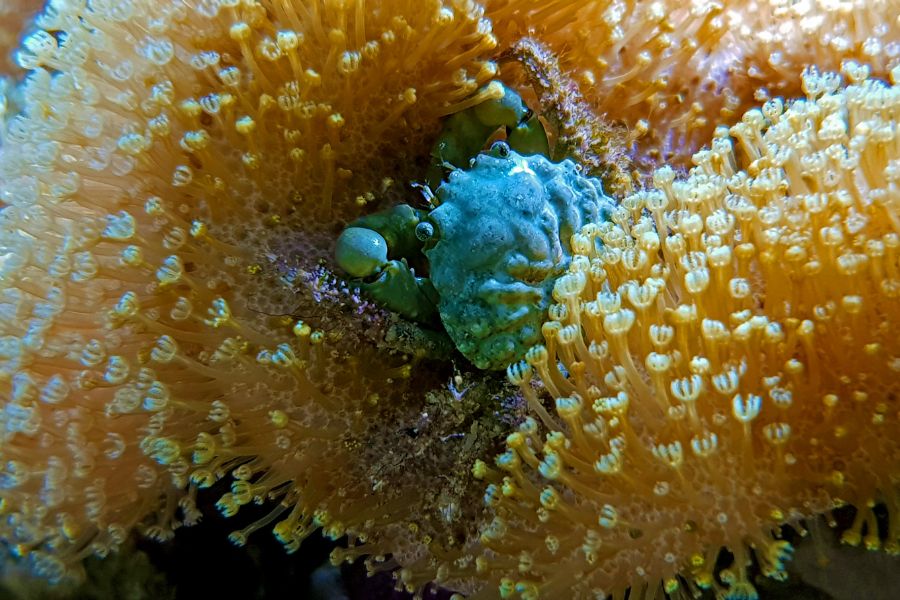Emerald crabs are highly sought after among aquarists due to their appearance and appetite for algae, however it can nonetheless be daunting if it’s your first time caring for one.
In this article, we’ll be taking a look at emerald crabs in detail, including their physical traits, lifespan, diet, and care methods.
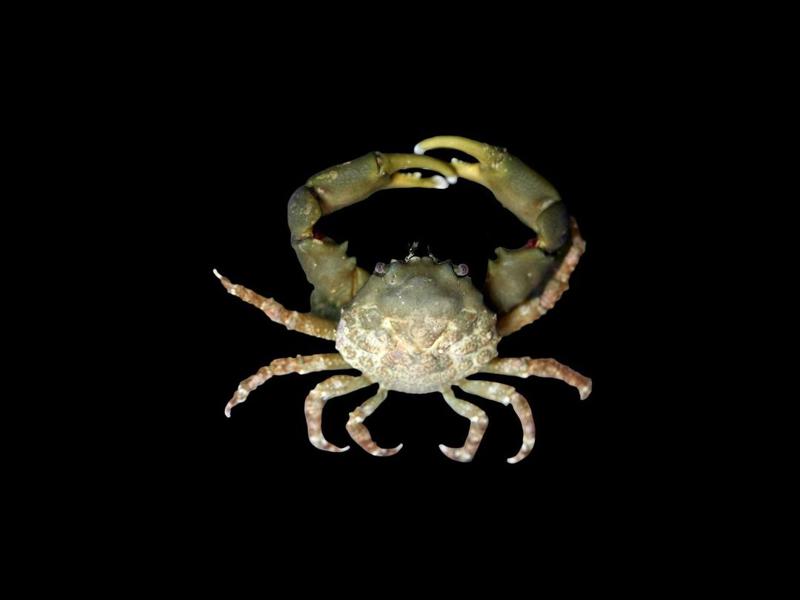
The emerald crab can be distinguished by its deep green coloration, and can typically live around 2-4 years while consuming a diet mainly consisting of different types of algae, detritus, dried seaweed, shrimp, and seaweed, among others.
Caring for them is rather easy as emerald crabs are quite hardy, however there are still certain parameters to follow.
Before moving onto caring for emerald crabs, let’s first dive a bit into what these crabs really are and what makes them a great addition to your aquarium.
What Are Emerald Crabs?
Emerald crabs (scientific name: Mithraculus sculptus) are some of the best aquarium cleaners around due to their tendency to consume all types of algae, as well as various types of detritus.
Other names for the emerald crab include emerald mithrax crab and the green clinging crab.
Though choosing tank mates for emerald crabs might be a somewhat complicated matter, the crabs are overall very efficient in supporting the overall aquarium ecosystem.
Native Origins of The Crab
The emerald crab is native to the shallow waters around the Caribbean and the Gulf of Mexico. In these areas, the crab is usually found around reefs and rocky outcrops, where there is often an abundance of food for them to feed.
Emerald crabs are nocturnal by nature, meaning they spend most of the daytime hiding under rocks or in crevices, before coming out at night to scavenge and spawn. They may, however, outgrow their shyness and come out during the day once they’ve gotten used to living in your aquarium.
Their Size and Physical Description
When fully matured, emerald crabs usually average about 2 inches in length, however there’s quite a bit of variability when it comes to these crabs. You may find crabs ranging from less than 1.5 inches long to others close to 2.5 inches, the reason of which is usually due to genetics.
The emerald crab gets its name from its shell coloration, which is usually a shiny deep green. Some white spots are sometimes seen around the carapace, claws, and the tips of their legs, but the majority of the crab is green.
Body wise, the emerald crab has a unique appearance in that not only is their body longer than it is wide, but their carapace is also nearly flat, which allows the crab to crawl under rocks for shelter. The shell itself has an overall rocky texture.
Emerald crabs have eight long, thin, and hairy back legs (appearing as four pairs), along with two large, smooth, and spoon-shaped claws in the front.
The Lifespan of The Crab
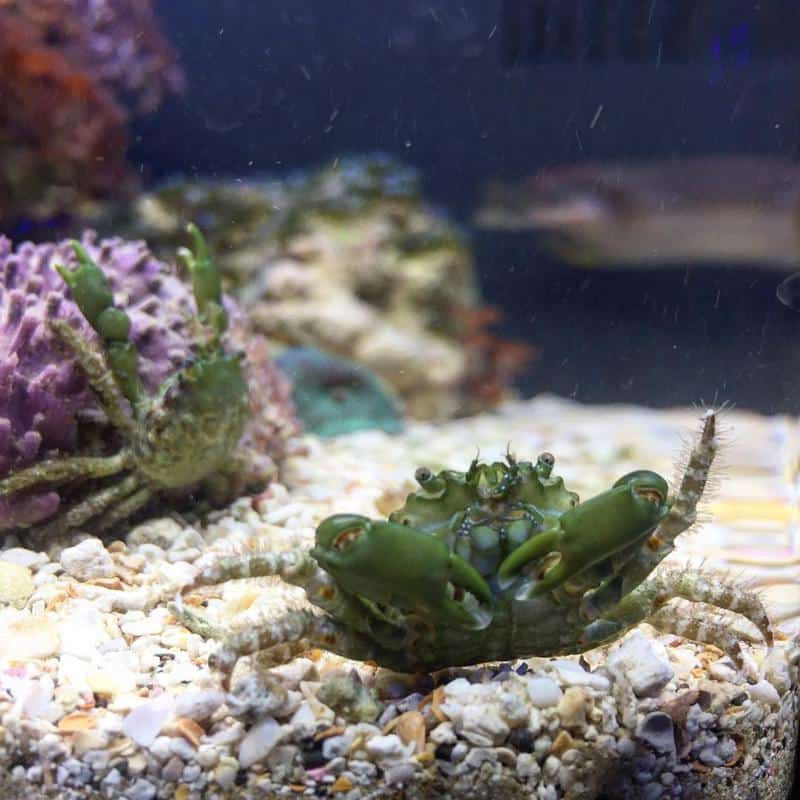
The average lifespan of an emerald crab ranges from two to four years. Even though these crabs aren’t the longest living invertebrates, they do outlast the majority of cleaner shrimp.
As per usual, the lifespan of your emerald crab will depend heavily on the situation of your aquarium (i.e. water conditions, potential for overpopulation, etc.) and the care you provide.
Even though these crabs live to at most four years in the wild, they have the potential to live for a much longer period of time in captivity given they receive the proper care (i.e. a balanced nutritional diet) and are living in a stable environment.
The Emerald Crab’s Diet
Similar to other crab species, the emerald crab is a natural scavenger, meaning it’ll consume a wide array of foods. For this crab in captivity, it usually means various types of algae and leftover food from its tankmates.
Crab’s Diet in the Wild
In the wild, the emerald crab mainly feeds on hair algae and bubble algae, which they gather from coral reefs, hence helping control the growth of these algae in their local ecosystems. However, these crabs are scavengers, meaning they’ll also consume just about anything else that comes their way.
Crab’s Diet in Captivity
Even though emerald crabs can be great as an aquarium cleaner, it’s important to ensure the crab has enough to eat so that it doesn’t potentially go after small organisms in your aquarium.
Besides the bubble and hair algae, along with the random detritus and leftover foods they consume in the water, here are some common foods that do well to supplement their diet:
- Dried seaweed/nori
- Algae sheets
- Mysis shrimp (chopped)
- Brine shrimp (chopped)
- Commercial pellets
- Live microalgae
Overall, emerald crabs aren’t picky eaters, so you can confidently provide these and various other types of fresh/frozen foods to them without worrying about the crabs not accepting them.
One thing to keep in mind is that even though it’s not recommended to have a lack of algae for these crabs to consume, it’s also not a good idea to have too much algae (i.e. from an algal bloom) in your tank.
These crabs (which you’ll usually only have one in your tank due to reasons we’ll look at later) may not be able to eat up a significant amount of the algae, thus a large accumulation will end up requiring manual removal and adjustment of the water.
Caring for Emerald Crabs
Although emerald crabs are known to be a hardy and versatile species that’s able to take care of itself quite well, they’ll nonetheless need a bit of help from you if you wish for them to live to their fullest potential.
Here’s some of the essential things you’ll need to consider when caring for them:
Choosing the Right Tank
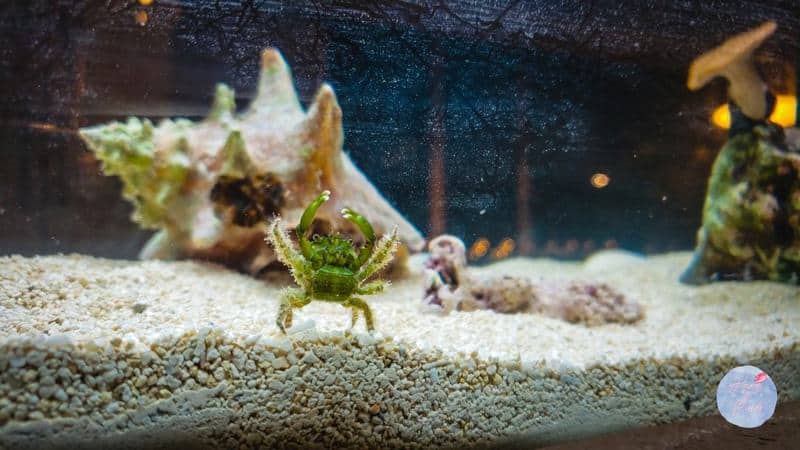
Emerald crabs can live in various tank sizes, but they’ll usually need some amount of scavenging space, otherwise its possible they’ll become aggressive. Hence, its typically recommended to always go for a larger tank if in doubt.
A tank size of roughly 20 to 30 gallons is recommended for a single emerald crab.
Adding a Substrate and Setting up The Tank
Since emerald crabs usually live around rocky areas that contain various types of lifeforms, it’s best to try to replicate that as much as possible in your tank. Here are some things to add to your tank:
- Begin with adding a layer of sand as your substrate
- Add a variety of rocks to form a live rock arrangement. The crabs will use the nooks and crannies of these rocks to hide during the day, as they’re mainly nocturnal animals.
Even though they may eventually gather the courage to emerge during the day, the crabs will nonetheless need to have these rocks as shelter.
The rocks might also accumulate algae over time, turning them into a highly sought-after food source for the crabs.
- You may decide to add coral to the tank, which can help create a more natural appearance, however this is completely optional
- You may add some live plants to your tank in order to closer replicate the crab’s natural habitat, with turtle grass being the preferred choice. The crabs may also consume the microorganisms that dwell on the leaves of these plants
- Finally, these crabs prefer a medium amount of lighting. This ensures that when the crabs eventually do decide to come out during the day, that they won’t be too overwhelmed by the light as they’re normally nocturnal animals
Adjusting the Water Parameters
Emerald crabs are a highly adaptable species that are not picky when it comes to specific water parameters in your aquarium. However, there are some general rules of thumb for you to follow if you wish to provide the best environment for your crab to live in.
Emerald crabs need to live in saltwater marine aquariums, where the waters are warm and slightly alkaline/basic.
The best temperatures for your crab would be within the range of 72 to 82 degrees Fahrenheit (preferably above 75 degrees if possible). Be sure to have a thermometer handy to measure the temperature, as well as an aquarium heater/chiller to adjust the temperature when necessary.
The pH of the water should be between 8.0 and 8.4, the exact level of which can be measured using an electronic pH meter or a liquid test kit.
The water hardness should be between 8 to 12 dKH, the exact level of which can be measured by using a liquid test kit that involves a colorimetric titration with an EDTA solution.
Nitrates and phosphates should be controlled, as they help facilitate the growth of algae. This can be beneficial for your crab, but too much of the algae will eventually overwhelm the crab and require you to manually remove the former.
Water tests should be performed using a liquid testing kit before you introduce your crab to the aquarium, so that you can make any necessary adjustments before they start causing a problem.
Potential Diseases Affecting Emerald Crabs
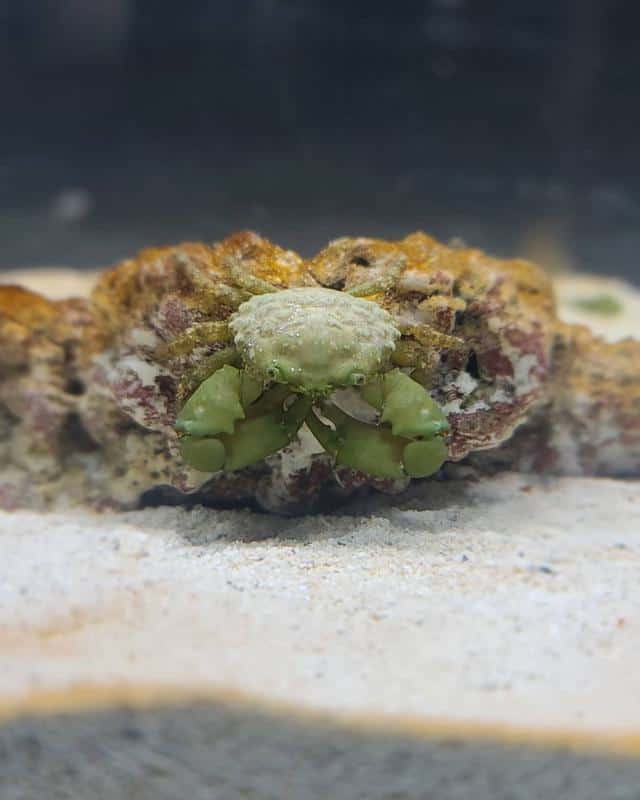
No disease specifically targets emerald crabs; however, the crabs are susceptible to most of the health problems experienced by other marine invertebrates.
A common ailment concerning emerald crabs is shell disease, which is typically caused by a viral or bacterial infection. The infection can lead to indentation marks on the shell and legs and, if allowed to progress far enough, might eventually breach through entirely and affect your crab’s internal body.
Mites and parasitic infections are also quite common, with emerald crabs sometimes carrying marine Ich. This parasite doesn’t harm the crab, but instead uses it as a host to allow it to infect other fish in the aquarium.
Regardless of the disease your crab is suffering from, it’s important to always quarantine them first to a secondary tank before providing them the appropriate treatment. Be sure to avoid any copper-based medication.
As long as you properly monitor the tank and quarantine new inhabitants before adding them to your tank, you should be able to avoid most if not all of these common diseases.
Also Read: Vampire Crab
FAQs
1. How Many Emerald Crabs Should Be Added per Gallon of Water?
Preferably, your tank should only contain one emerald crab (or two of opposite sexes) as male emerald crabs can become quite aggressive with each other.
If you choose to have additional crabs, remember that even though it’s said you can add one crab for every 10 gallons of water, its preferred if you have one crab for every 30 gallons instead.
2. Do Emerald Crabs Molt?
Emerald crabs do molt from time to time as they outgrow their old shells, however the rate is entirely dependent on a variety of factors.
After they molt, they’ll abandon their old shells and often hide for several days until their new shell hardens.
Conclusion
Emerald crabs can benefit your aquarium in many ways, and with the right type of care, you should have no trouble making the crab an excellent tank mate with your other marine inhabitants.
